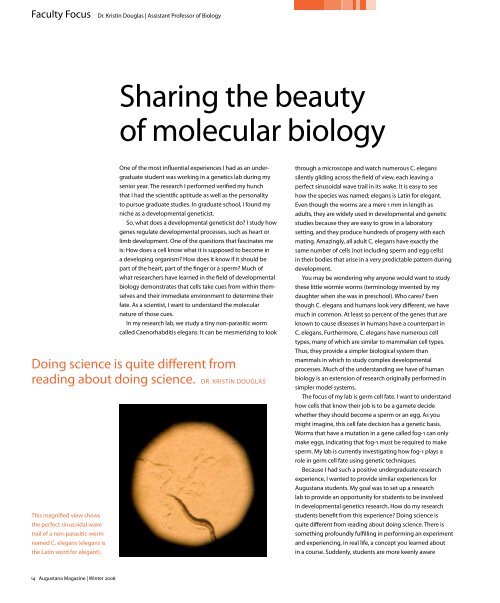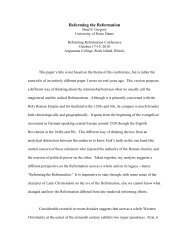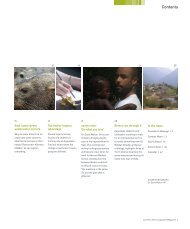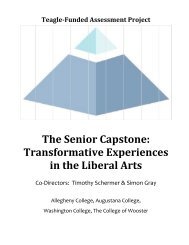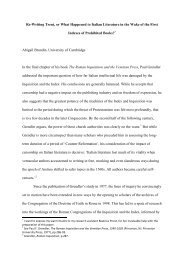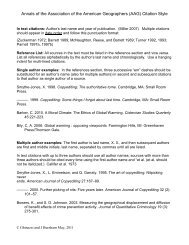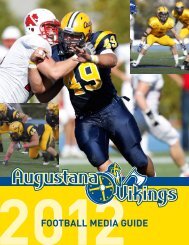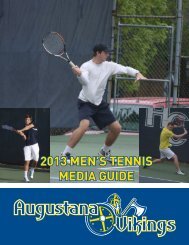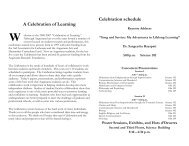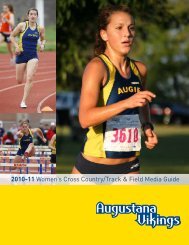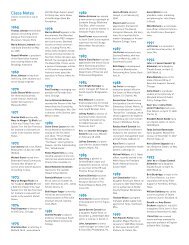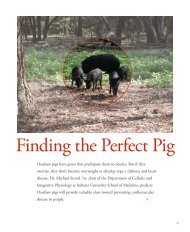Sharing the beauty of molecular biology - Augustana College
Sharing the beauty of molecular biology - Augustana College
Sharing the beauty of molecular biology - Augustana College
You also want an ePaper? Increase the reach of your titles
YUMPU automatically turns print PDFs into web optimized ePapers that Google loves.
Faculty Focus Dr. Kristin Douglas | Assistant Pr<strong>of</strong>essor <strong>of</strong> Biology<br />
4 <strong>Augustana</strong> Magazine | Winter 2008<br />
<strong>Sharing</strong> <strong>the</strong> <strong>beauty</strong><br />
<strong>of</strong> <strong>molecular</strong> <strong>biology</strong><br />
One <strong>of</strong> <strong>the</strong> most influential experiences I had as an undergraduate<br />
student was working in a genetics lab during my<br />
senior year. The research I performed verified my hunch<br />
that I had <strong>the</strong> scientific aptitude as well as <strong>the</strong> personality<br />
to pursue graduate studies. In graduate school, I found my<br />
niche as a developmental geneticist.<br />
So, what does a developmental geneticist do? I study how<br />
genes regulate developmental processes, such as heart or<br />
limb development. One <strong>of</strong> <strong>the</strong> questions that fascinates me<br />
is: How does a cell know what it is supposed to become in<br />
a developing organism? How does it know if it should be<br />
part <strong>of</strong> <strong>the</strong> heart, part <strong>of</strong> <strong>the</strong> finger or a sperm? Much <strong>of</strong><br />
what researchers have learned in <strong>the</strong> field <strong>of</strong> developmental<br />
<strong>biology</strong> demonstrates that cells take cues from within <strong>the</strong>mselves<br />
and <strong>the</strong>ir immediate environment to determine <strong>the</strong>ir<br />
fate. As a scientist, I want to understand <strong>the</strong> <strong>molecular</strong><br />
nature <strong>of</strong> those cues.<br />
In my research lab, we study a tiny nonparasitic worm<br />
called Caenorhabditis elegans. It can be mesmerizing to look<br />
Doing science is quite different from<br />
reading about doing science. DR. KRISTIN DOUGLAS<br />
This magnified view shows<br />
<strong>the</strong> perfect sinusoidal wave<br />
trail <strong>of</strong> a nonparasitic worm<br />
named C. elegans (elegans is<br />
<strong>the</strong> Latin word for elegant).<br />
through a microscope and watch numerous C. elegans<br />
silently gliding across <strong>the</strong> field <strong>of</strong> view, each leaving a<br />
perfect sinusoidal wave trail in its wake. It is easy to see<br />
how <strong>the</strong> species was named; elegans is Latin for elegant.<br />
Even though <strong>the</strong> worms are a mere mm in length as<br />
adults, <strong>the</strong>y are widely used in developmental and genetic<br />
studies because <strong>the</strong>y are easy to grow in a laboratory<br />
setting, and <strong>the</strong>y produce hundreds <strong>of</strong> progeny with each<br />
mating. Amazingly, all adult C. elegans have exactly <strong>the</strong><br />
same number <strong>of</strong> cells (not including sperm and egg cells)<br />
in <strong>the</strong>ir bodies that arise in a very predictable pattern during<br />
development.<br />
You may be wondering why anyone would want to study<br />
<strong>the</strong>se little wormie worms (terminology invented by my<br />
daughter when she was in preschool). Who cares? Even<br />
though C. elegans and humans look very different, we have<br />
much in common. At least 50 percent <strong>of</strong> <strong>the</strong> genes that are<br />
known to cause diseases in humans have a counterpart in<br />
C. elegans. Fur<strong>the</strong>rmore, C. elegans have numerous cell<br />
types, many <strong>of</strong> which are similar to mammalian cell types.<br />
Thus, <strong>the</strong>y provide a simpler biological system than<br />
mammals in which to study complex developmental<br />
processes. Much <strong>of</strong> <strong>the</strong> understanding we have <strong>of</strong> human<br />
<strong>biology</strong> is an extension <strong>of</strong> research originally performed in<br />
simpler model systems.<br />
The focus <strong>of</strong> my lab is germ cell fate. I want to understand<br />
how cells that know <strong>the</strong>ir job is to be a gamete decide<br />
whe<strong>the</strong>r <strong>the</strong>y should become a sperm or an egg. As you<br />
might imagine, this cell fate decision has a genetic basis.<br />
Worms that have a mutation in a gene called fog can only<br />
make eggs, indicating that fog must be required to make<br />
sperm. My lab is currently investigating how fog plays a<br />
role in germ cell fate using genetic techniques.<br />
Because I had such a positive undergraduate research<br />
experience, I wanted to provide similar experiences for<br />
<strong>Augustana</strong> students. My goal was to set up a research<br />
lab to provide an opportunity for students to be involved<br />
in developmental genetics research. How do my research<br />
students benefit from this experience? Doing science is<br />
quite different from reading about doing science. There is<br />
something pr<strong>of</strong>oundly fulfilling in performing an experiment<br />
and experiencing, in real life, a concept you learned about<br />
in a course. Suddenly, students are more keenly aware
<strong>of</strong> <strong>the</strong> process <strong>of</strong> science and how scientific knowledge is<br />
discovered.<br />
Of course, students practice a variety <strong>of</strong> laboratory skills<br />
and learn many “tools <strong>of</strong> <strong>the</strong> trade” <strong>of</strong> genetic analysis.<br />
We read primary literature and talk about how to ask and<br />
answer biological questions. Students have <strong>the</strong> freedom<br />
to independently design experiments probing at <strong>the</strong> larger<br />
question <strong>of</strong> germ cell fate, while I <strong>of</strong>fer advice based on my<br />
experience and expertise.<br />
Working with biological systems is an art in and <strong>of</strong> itself.<br />
Organisms do not always behave as expected. Students<br />
learn how to be flexible when designing and analyzing<br />
experiments, and <strong>the</strong>y learn that obtaining reproducible<br />
results means repeating <strong>the</strong> same experiment over and over<br />
with slight variations in <strong>the</strong> protocol until <strong>the</strong> results are<br />
consistent. Generating data is only <strong>the</strong> beginning. Students<br />
also gain experience in data analysis and presentation. Each<br />
year, my lab presents ei<strong>the</strong>r a poster presentation or a talk<br />
at <strong>Augustana</strong>’s Celebration <strong>of</strong> Learning. Additionally, <strong>the</strong><br />
students’ research is highlighted at regional and national<br />
scientific conferences I attend.<br />
Being a research mentor is very different from being <strong>the</strong><br />
instructor <strong>of</strong> a course. I find <strong>the</strong> oneonone interactions<br />
to be energizing, and I love being around students who<br />
marvel at <strong>the</strong> <strong>beauty</strong> <strong>of</strong> <strong>molecular</strong> <strong>biology</strong> as much as I do.<br />
I find mentoring to be one <strong>of</strong> <strong>the</strong> most rewarding aspects<br />
<strong>of</strong> my job. Having mentored many extremely talented and<br />
fun students, I have come to realize that, perhaps, <strong>the</strong><br />
most important aspect <strong>of</strong> my research lab is <strong>the</strong> mentoring<br />
relationship I have with my students.<br />
Yes, students learn about <strong>the</strong> science, and <strong>the</strong>y learn<br />
what it is like to work in a research lab, but I think <strong>the</strong>y learn<br />
much, much more. I think <strong>the</strong>y learn that scientists are<br />
regular people who have a life outside <strong>of</strong> <strong>the</strong> lab. They learn<br />
that it is okay not to know everything. It is okay to ask for<br />
help—and it is okay to have fun while you are working!<br />
My influence on my students may not be pr<strong>of</strong>ound, but<br />
my hope is that I have helped to shape <strong>the</strong>ir view <strong>of</strong> science<br />
and <strong>the</strong> people who do science. Along <strong>the</strong> way, I have made<br />
some lifelong friends. I am excited to receive emails and<br />
phone calls from my former students. I love hearing <strong>the</strong>m<br />
explain <strong>the</strong>ir research to me, and I hope <strong>the</strong>y will invite me<br />
to Stockholm when one <strong>of</strong> <strong>the</strong>m wins <strong>the</strong> Nobel Prize.<br />
Ashley Caravelli ‘08<br />
researches developmental<br />
genetics in Dr. Kristin<br />
Douglas’ lab.<br />
Winter 2008 | <strong>Augustana</strong> Magazine 5
(Book)Mark Our Words<br />
Looking for a fictional work or mindstretching social commentary to read?<br />
Avid readers within our campus community recommend <strong>the</strong> following books.<br />
Field Notes from a Catastrophe:<br />
Man, Nature, and Climate Change<br />
by Elizabeth Kolbert<br />
There are very few books I wish<br />
everybody would read; this is one.<br />
A stunning read when it first<br />
appeared two years ago in <strong>the</strong> New<br />
Yorker, Field Notes is already a<br />
classic. Kolbert traveled <strong>the</strong> globe to<br />
places where <strong>the</strong> disruptive effects<br />
<strong>of</strong> global warming are unmistakable,<br />
and writes deftly and calmly about<br />
what difference climate change is<br />
making to ordinary people on <strong>the</strong><br />
ground, <strong>the</strong> coasts, <strong>the</strong> islands,<br />
<strong>the</strong> ice. She also hangs with some<br />
<strong>of</strong> <strong>the</strong> bestinformed, cleares<strong>the</strong>aded<br />
experts. This is never a<br />
gloomy, strident or depressing<br />
book. Kolbert writes exactly <strong>the</strong><br />
way we teach students to write:<br />
she shows, ra<strong>the</strong>r than tells; she<br />
keeps a low pr<strong>of</strong>ile; and she lets <strong>the</strong><br />
facts speak for <strong>the</strong>mselves, which<br />
<strong>the</strong>y do, with grace and force. Field<br />
Notes is now <strong>of</strong>ten compared (fairly,<br />
I’d say) with Silent Spring. Nearly<br />
everybody paying attention now<br />
understands that global warming is<br />
<strong>the</strong> defining challenge <strong>of</strong> our age;<br />
this book is part <strong>of</strong> how this recent<br />
consensus has formed, and why it<br />
is so energetic and civil. • Dr. Don<br />
Erickson, English department<br />
Ella Minnow Pea by Mark Dunn<br />
The book is set in a fictional<br />
town with a statue <strong>of</strong> <strong>the</strong> town<br />
founder proclaiming <strong>the</strong> sentence:<br />
The quick brown fox jumps over<br />
<strong>the</strong> lazy dog. Townspeople find this<br />
6 <strong>Augustana</strong> Magazine | Winter 2008<br />
sentence amazing as it includes<br />
all <strong>the</strong> alphabet’s characters in<br />
only eight words. Problems ensue<br />
when letters start to fall from<br />
<strong>the</strong> statue’s placard (a possible<br />
omen), and <strong>the</strong> town council bans<br />
<strong>the</strong>ir usage in verbal or written<br />
communication. The book is witty<br />
and interestingly written by a<br />
talented author who tells <strong>the</strong> story<br />
using <strong>the</strong> townspeople’s letters and<br />
notes. • Dr. Sarah Lovern, <strong>biology</strong><br />
department<br />
A Man Without a Country by Kurt<br />
Vonnegut<br />
Kurt Vonnegut’s wit, wisdom and<br />
irreverence combine to ask <strong>the</strong><br />
kinds <strong>of</strong> questions that Americans<br />
have pondered for generations.<br />
One <strong>of</strong> those asks why some folks<br />
want <strong>the</strong> Ten Commandments in<br />
public places like courthouses<br />
and schools, but <strong>the</strong>y never ask<br />
for Jesus’ Sermon on <strong>the</strong> Mount. •<br />
Dr. Paul Olsen, English department<br />
Troublesome Young Men: The<br />
Rebels Who Brought Churchill to<br />
Power and Helped Save England<br />
by Lynne Olson<br />
This book came to my attention as<br />
a recommendation from amazon.<br />
com. Minutes into reading <strong>the</strong><br />
online excerpt, I was hooked<br />
and knew I had to have it. Lynne<br />
Olson tells a riveting story <strong>of</strong><br />
<strong>the</strong> small group <strong>of</strong> Tory antiappeasement<br />
backbenchers that<br />
battled <strong>the</strong> stranglehold <strong>of</strong> Neville<br />
Chamberlain’s Tory party machine to<br />
topple Chamberlain, make Winston<br />
Churchill prime minister and save<br />
England—and perhaps Western<br />
civilization. Chamberlain’s dictatorial<br />
attitude, extreme secrecy, endruns<br />
around Parliament and wholesale<br />
wiretapping that Olson documents<br />
parallel current events. The book<br />
provides thumbnail sketches <strong>of</strong><br />
everyone <strong>of</strong> any significance in mid<br />
20th century British politics. An<br />
excellent read! • Dr. Kurt Christ<strong>of</strong>fel,<br />
chemistry department<br />
Eating Beauty: The Eucharist and<br />
<strong>the</strong> Spiritual Arts <strong>of</strong> <strong>the</strong> Middle<br />
Ages by Ann W. Anstell<br />
Written by a Purdue University<br />
pr<strong>of</strong>essor <strong>of</strong> English, Eating<br />
Beauty examines late Medieval<br />
Eucharistic devotion through <strong>the</strong><br />
eyes <strong>of</strong> important works <strong>of</strong> art<br />
from <strong>the</strong> same period and early<br />
Renaissance. It brings visual life<br />
to what at times may seem abstract<br />
doctrinal issues, while placing<br />
works <strong>of</strong> art into specific religious<br />
and intellectual milieux in a way<br />
that is accessible to <strong>the</strong> general<br />
reader as well as <strong>the</strong> specialist (in<br />
particular, providing both original<br />
Latin texts and translations). Eleven<br />
color photographs make a number<br />
<strong>of</strong> <strong>the</strong> works immediately available<br />
to <strong>the</strong> reader. This book falls into <strong>the</strong><br />
new Catholic <strong>the</strong>ology discipline also<br />
evidenced, for example, in Ca<strong>the</strong>rine<br />
Pickstock’s After Writing, but is far<br />
more easily read. A penultimate<br />
chapter comparing <strong>the</strong> aes<strong>the</strong>tics<br />
<strong>of</strong> Simone Weil and G.F. Hegel<br />
engages <strong>the</strong> events <strong>of</strong> <strong>the</strong> Holocaust<br />
in a way that brings <strong>the</strong> discussion<br />
into contemporary application.<br />
• Dr. William Swatos Jr., sociology,<br />
anthropology and social welfare<br />
department<br />
The God <strong>of</strong> Animals by Aryn Kyle<br />
Taking place on a horse ranch in<br />
Colorado, this first novel is, in part,<br />
a horse story that surprised me with<br />
its intricacy and emotional pull.<br />
Equally enthralling is <strong>the</strong> inner life<br />
<strong>of</strong> 2yearold Alice who struggles to<br />
understand <strong>the</strong> people in her world<br />
who are leaving her: a drowned classmate,<br />
depressed mo<strong>the</strong>r, runaway<br />
sister, and stubborn, harddriving<br />
fa<strong>the</strong>r. Latching on to a teacher who<br />
is battling his own demons, Alice<br />
clings to innocence while coming to<br />
terms with her place in <strong>the</strong> world.<br />
A tough story delicately written.<br />
• Margi Rogal, Thomas Tredway<br />
Library<br />
The Women Who Raised Me: A<br />
Memoir by Victoria Rowell<br />
This is a very moving book about a<br />
woman who was raised by various<br />
foster mo<strong>the</strong>rs and is now a dancer/<br />
actress. The wellwritten story<br />
explores many issues, including<br />
creativity, selfawareness, race,<br />
adoption and mental health. •<br />
Rowen SchussheimAnderson, art<br />
department
The Road by Cormac McCarthy<br />
Cormac McCarthy’s most recent<br />
book The Road is a brilliant, terrifying<br />
and beautiful novel—his most<br />
ambitious yet. McCarthy portrays<br />
a world destroyed by nuclear holocaust.<br />
A fa<strong>the</strong>r and son, never<br />
named, follow a road through<br />
this barren, ashcovered land in<br />
which <strong>the</strong> only survivors <strong>of</strong> war are<br />
reduced to desperate acts <strong>of</strong> <strong>the</strong><br />
worst sort.<br />
We are drawn to this gripping<br />
story, however, not for <strong>the</strong> anguished<br />
setting—nuclear winter in<br />
America—but ra<strong>the</strong>r for <strong>the</strong> human<br />
drama at its center. McCarthy posits<br />
a world destroyed by unbelief in<br />
which, through nothing less than<br />
miracle, belief is nurtured and<br />
sustained.<br />
McCarthy’s book is at once<br />
devastating and inspiring. It reminds<br />
me why we read novels in <strong>the</strong> first<br />
place. We read to understand our<br />
humanity. We read to know ourselves.<br />
We read Cormac McCarthy to<br />
contemplate how we might bridge<br />
<strong>the</strong> fearful gulf between o<strong>the</strong>rs and<br />
ourselves. For McCarthy, this is <strong>the</strong><br />
way to God. • Dr. Jeff Abernathy,<br />
academic affairs and English<br />
department<br />
The Twelve Little Cakes by<br />
Dominika Dery<br />
Dominika Dery was born to dissident<br />
parents in 975 Czechoslovakia<br />
and writes <strong>of</strong> her childhood in<br />
communist Eastern Europe in this<br />
memoir. Included are many stories<br />
about <strong>the</strong> persecution she and her<br />
family encountered because <strong>of</strong> her<br />
parents’ involvement in <strong>the</strong> Czech<br />
reform movement that was crushed<br />
by <strong>the</strong> Soviets in 968. Through a<br />
child’s nonjudgmental perspective,<br />
<strong>the</strong> book exposes many <strong>of</strong> <strong>the</strong> lies<br />
and hypocrisy <strong>of</strong> <strong>the</strong> leftist ideology<br />
that Dery and her countrymen<br />
suffered through during <strong>the</strong><br />
communist era. • Brent Etzel,<br />
Thomas Tredway Library<br />
Blackhawk: The Battle for <strong>the</strong><br />
Heart <strong>of</strong> America by Kerry A.<br />
Trask<br />
Kerry Trask’s book is fascinating<br />
reading for anyone who has spent<br />
much time at <strong>Augustana</strong>. Our<br />
campus is less than four miles from<br />
<strong>the</strong> Sauk Village <strong>of</strong> Saukenuk, which<br />
was <strong>the</strong> largest village in Illinois in<br />
<strong>the</strong> early 800s. Black Hawk noted<br />
that Saukenuk was a place where<br />
people could live “as happy as <strong>the</strong><br />
buffalo on <strong>the</strong> plains.” As I walk<br />
through <strong>the</strong> campus each morning,<br />
I can only imagine what a paradise<br />
this must have been.<br />
This book describes <strong>the</strong> events<br />
leading up to <strong>the</strong> Black Hawk War,<br />
which took place less than 30 years<br />
before <strong>Augustana</strong> was founded.<br />
The Sauk sought to preserve<br />
<strong>the</strong>ir way <strong>of</strong> life, first through<br />
accommodation and <strong>the</strong>n through<br />
a tragic conflict. One wonders<br />
about parallels today as our own<br />
culture seeks to interface with longestablished<br />
cultures in <strong>the</strong> Middle<br />
East. Have we learned enough to<br />
avoid <strong>the</strong> mistakes <strong>of</strong> <strong>the</strong> past? •<br />
Steve Bahls, president’s <strong>of</strong>fice<br />
I’ve been reading Vietnam<br />
literature lately, preparing for a<br />
Vietnam term. I’ve always liked Tim<br />
O’Brien’s best books, The Things<br />
They Carried with its surreal stories<br />
and In <strong>the</strong> Lake <strong>of</strong> <strong>the</strong> Woods, which<br />
is set in contemporary Minnesota<br />
but flashes back to <strong>the</strong> My Lai<br />
massacre. But I’ve also been reading<br />
books from a Vietnamese point<br />
<strong>of</strong> view, such as The Sorrow <strong>of</strong> War<br />
by Bao Ninh and Robert Olin<br />
Butler’s A Good Scent from a Strange<br />
Mountain. Bao Ninh writes about his<br />
and o<strong>the</strong>rs’ combat experiences<br />
with <strong>the</strong> North Vietnamese army,<br />
and Butler writes about Vietnamese<br />
refugees living in and around New<br />
Orleans. Both are excellent. •<br />
Dr. David Crowe, English<br />
department<br />
Harry Potter and The Deathly<br />
Hallows by J.K. Rowling<br />
Interviewers who have asked J.K.<br />
Rowling whe<strong>the</strong>r Harry Potter’s<br />
story is Christian have been met<br />
with <strong>the</strong> response, “Wait until<br />
<strong>the</strong> end <strong>of</strong> <strong>the</strong> seventh book and<br />
you will see.” True to her word, in<br />
Deathly Hallows, Rowling presents<br />
us with an ending in which love is<br />
at <strong>the</strong> center, a love defined as a<br />
willingness to lay down one’s life on<br />
behalf <strong>of</strong> ano<strong>the</strong>r (see John 5: 3).<br />
Along <strong>the</strong> way, Harry faces <strong>the</strong><br />
lure <strong>of</strong> personal ambition versus<br />
<strong>the</strong> good <strong>of</strong> <strong>the</strong> wider community,<br />
<strong>the</strong> nature <strong>of</strong> evil is dealt with in a<br />
provocative way, and unlikely heroes<br />
appear and triumph just when<br />
<strong>the</strong>y are needed. • Pastor Richard<br />
Priggie ’74, campus ministries<br />
The Mind and <strong>the</strong> Brain: Neuroplasticity<br />
and <strong>the</strong> Power <strong>of</strong> Mental<br />
Force by Jeffrey M. Schwartz and<br />
Sharon Begley<br />
This book argues that <strong>the</strong> mind<br />
is far more flexible and able to<br />
develop new abilities, far different<br />
from <strong>the</strong> pessimistic views <strong>of</strong><br />
inevitable decline that we all have<br />
heard. In fact, Jeffrey Schwartz,<br />
who developed effective treatments<br />
for obsessivecompulsive disorder,<br />
argues that conscious attention<br />
can literally change <strong>the</strong> brain’s<br />
structure. Though a later chapter<br />
on free will and alleged quantum<br />
effects at <strong>the</strong> synapse level is less<br />
convincing, <strong>the</strong> book is thoughtprovoking,<br />
accessible and will elicit<br />
a sense <strong>of</strong> wonder at <strong>the</strong> human<br />
brain and mind. • Dr. Michael Nolan<br />
’77, academic affairs<br />
The Omnivore’s Dilemma: A<br />
Natural History <strong>of</strong> Four Meals by<br />
Michael Pollan<br />
People who like to eat should know<br />
something about <strong>the</strong>ir food. Those<br />
who eat in ignorance should ei<strong>the</strong>r<br />
stop eating altoge<strong>the</strong>r and leave <strong>the</strong><br />
food for <strong>the</strong> rest <strong>of</strong> us or read this<br />
book. • Dr. Jason Peters, English<br />
department<br />
Winter 2008 | <strong>Augustana</strong> Magazine 7
The endowment<br />
advantage<br />
Dr. Tom Bengtson ’75 and Shaun Callighan ’08<br />
8 <strong>Augustana</strong> Magazine | Winter 2008<br />
A college’s endowment provides longterm<br />
financial strength and creates remarkable<br />
opportunities for students and faculty.<br />
By Lee Nelson
empowered<br />
They listened to <strong>the</strong> brightest math scholars converse about intriguing concepts,<br />
<strong>the</strong>ories and research. They rubbed elbows with toprated college math pr<strong>of</strong>essors<br />
from around <strong>the</strong> country. A trip to MathFest 2007 in San Jose, Calif., this past<br />
summer gave six <strong>Augustana</strong> students <strong>the</strong> opportunity to delve into a side <strong>of</strong> math <strong>the</strong>y<br />
probably never would have witnessed if not for <strong>the</strong> power <strong>of</strong> <strong>the</strong> college’s endowment.<br />
“They got to see people o<strong>the</strong>r than just <strong>Augustana</strong> pr<strong>of</strong>essors excited about math,”<br />
says Dr. Tom Bengtson ’75, who holds <strong>the</strong> Earl H. Beling Chair in Ma<strong>the</strong>matics, one<br />
<strong>of</strong> <strong>the</strong> college’s endowed faculty chairs. “They got to see lots <strong>of</strong> o<strong>the</strong>r students also<br />
really excited about math. I’m in an enviable position to be able to bring our students<br />
to <strong>the</strong>se types <strong>of</strong> events. It’s tremendously empowering.”<br />
<strong>Augustana</strong>’s endowment funds not only faculty chair<br />
positions, but also student scholarships (see “Scholarships<br />
help shape students’ experiences,” page 22), facility improvements<br />
and <strong>the</strong> daytoday operations <strong>of</strong> <strong>the</strong> college.<br />
“Your top priority is to have an endowment that supports<br />
your mission,” says Al DeSimone, vice president for development.<br />
“If we didn’t have a strong endowment, we couldn’t<br />
<strong>of</strong>fer certain programs or launch new ones. We would have<br />
a lot less money for our students. It would be harder to<br />
attract and retain quality faculty. The endowment is also <strong>the</strong><br />
foundation <strong>of</strong> <strong>the</strong> college’s longterm stability that keeps <strong>the</strong><br />
college competitive. This is all central to our mission.”<br />
<strong>Augustana</strong>’s endowment operates much like a typical<br />
savings and investment portfolio in that <strong>the</strong> principal is<br />
invested and grows over time. To keep up with increasing<br />
demands, <strong>the</strong> endowment principal and market value must<br />
continue to grow through donations.<br />
In recent years <strong>the</strong> college’s endowment has grown by<br />
way <strong>of</strong> gifts <strong>of</strong> all sizes designated for a variety <strong>of</strong> purposes.<br />
Each donation is invested to continue that growth and<br />
income, and only 5 percent <strong>of</strong> <strong>the</strong> endowment’s market<br />
value is spent each year. At <strong>the</strong> end <strong>of</strong> <strong>the</strong> fiscal year on<br />
June 30, <strong>Augustana</strong>’s endowment had risen to $ 8,483,9 8,<br />
a dramatic increase from $7.5 million in 982.<br />
DeSimone is finding that many <strong>of</strong> <strong>Augustana</strong>’s donors are<br />
alumni who expect more accountability for <strong>the</strong>ir gifts. “They<br />
want to know what is being achieved with <strong>the</strong>ir money, and<br />
that’s a good thing,” he says. “The growing trend is that<br />
people want to see results <strong>of</strong> <strong>the</strong>ir philanthropy during <strong>the</strong>ir<br />
lifetimes.”<br />
Since <strong>the</strong> majority <strong>of</strong> <strong>Augustana</strong>’s current endowment is<br />
earmarked for scholarships, <strong>the</strong>re are limited resources to<br />
respond to new ideas from faculty for program development<br />
in core areas. Donors, however, may contribute specifically<br />
to an endowed academic venture fund that encourages<br />
entrepreneurial thinking among faculty and gives <strong>the</strong><br />
college <strong>the</strong> flexibility necessary to support <strong>the</strong> academic<br />
goals <strong>of</strong> <strong>the</strong> college’s strategic plan.<br />
Faculty chair positions, such as Bengtson’s chair endowed<br />
by <strong>the</strong> Beling family, are ano<strong>the</strong>r way donors may impact<br />
<strong>the</strong> college. Those who establish endowed faculty chairs are<br />
linked in perpetuity to <strong>the</strong> accomplishments <strong>of</strong> <strong>the</strong> succession<br />
<strong>of</strong> faculty members whose work <strong>the</strong>ir gifts support.<br />
These endowed faculty positions honor <strong>the</strong> achievement,<br />
expertise and seniority <strong>of</strong> <strong>the</strong> faculty member selected to<br />
hold each position. An endowed faculty chair is <strong>the</strong> highest<br />
reward for academic achievement, and <strong>of</strong>ten <strong>the</strong> key to<br />
attracting and retaining senior faculty (see “Endowed<br />
chairs,” p. 2 ).<br />
“It is definitely an affirmation <strong>of</strong> your job, and it is an<br />
affirmation <strong>of</strong> <strong>the</strong> school where you choose to work,”<br />
Bengtson says.<br />
Earnings on endowed faculty positions support salaries<br />
and provide funding for appointees to develop new courses<br />
or conduct collaborative research with students. These<br />
faculty may help students follow through on innovative ideas<br />
for research, independent projects and presentations. ><br />
Winter 2008 | <strong>Augustana</strong> Magazine 9
“An endowed chair says that your institution is recognizing<br />
and rewarding you for what you do in your discipline.” DR. PETER KIVISTO<br />
20 <strong>Augustana</strong> Magazine | Winter 2008<br />
Mentoring students<br />
When Bengtson was awarded <strong>the</strong> Earl H. Beling Chair in<br />
Ma<strong>the</strong>matics in <strong>the</strong> fall <strong>of</strong> 988, he knew he wanted to help<br />
students become involved in ma<strong>the</strong>matical research. “Now<br />
I can work with students who are doing research for longer<br />
than a term,” Bengtson says. “They can do projects that<br />
<strong>the</strong>y are interested in outside <strong>the</strong> classroom walls. I am a<br />
facilitator and way more than a lecturer to <strong>the</strong>m.”<br />
Shaun Callighan ’08 was one <strong>of</strong> <strong>the</strong> <strong>Augustana</strong><br />
students Bengtson took to MathFest 2007 in San Jose last<br />
summer. As one <strong>of</strong> Bengtson’s Beling scholars, he had<br />
started researching <strong>the</strong> mathrelated topic <strong>of</strong> cryptology,<br />
<strong>the</strong> science <strong>of</strong> making encrypted data unencrypted and<br />
keeping data secure. “At some point I became intrigued by<br />
probabilistic primes because encryption algorithms use<br />
large prime numbers, but finding large prime numbers can<br />
be a daunting task,” Callighan says.<br />
Callighan wonders if he would have been able to make<br />
<strong>the</strong> unexpected change in focus if his research had been for<br />
a regular class. “I also think <strong>the</strong> amount <strong>of</strong> time that was<br />
available to do research as a Beling scholar really helped,<br />
and Dr. Bengtson’s support helped a lot in creating a quality<br />
research project,” he says.<br />
Callighan enjoyed attending <strong>the</strong> national convention<br />
because he was able to present his research and receive<br />
feedback, and also see <strong>the</strong> results <strong>of</strong> o<strong>the</strong>r ma<strong>the</strong>maticians’<br />
work. “Overall, being a Beling scholar gives you a great<br />
research piece that can be shown to grad schools or even<br />
employers,” he says. “I hope that future students who get<br />
<strong>the</strong> opportunity to be Beling scholars take advantage <strong>of</strong> it.”<br />
Connecting with o<strong>the</strong>r scholars<br />
In addition to mentoring students oneonone, endowed<br />
faculty chairs also encourage and support faculty in <strong>the</strong>ir<br />
own scholarly research or artistic work. These faculty serve<br />
as models <strong>of</strong> <strong>the</strong> intellectual engagement and commitment<br />
<strong>the</strong> college seeks to promote in its students.<br />
Dr. Peter Kivisto, chair <strong>of</strong> <strong>the</strong> sociology department,<br />
serves as <strong>the</strong> Richard A. Swanson Pr<strong>of</strong>essor <strong>of</strong> Social<br />
Thought. Kivisto knew <strong>the</strong> late Richard Swanson—known<br />
to many as Swanie—very well through <strong>the</strong> years, and <strong>the</strong>y<br />
formed a bond as a result <strong>of</strong> <strong>the</strong> chair. When Kivisto was<br />
bestowed with <strong>the</strong> endowed chair, he was able to shape and<br />
define it to reflect his scholarly interests. Swanson, who was<br />
campus chaplain from 966 to 999, had a strong interest<br />
in many <strong>of</strong> <strong>the</strong> subjects Kivisto teaches and researches,<br />
including religion, social <strong>the</strong>ory, race and ethnic relations,<br />
and immigration.<br />
“People who are pr<strong>of</strong>essionally active—especially those<br />
at small colleges—need to be recognized,” Kivisto says. “An
endowed chair says that your institution is recognizing and<br />
rewarding you for what you do in your discipline.”<br />
Last summer Kivisto attended <strong>the</strong> “Transnationalisation<br />
and Development: Towards a NorthSouth Perspective”<br />
conference at <strong>the</strong> Center for Interdisciplinary Research<br />
at <strong>the</strong> University <strong>of</strong> Bielefeld in Bielefeld, Germany. The<br />
conference organizer is one <strong>of</strong> Kivisto’s colleagues, a<br />
German sociologist named Thomas Faist. Kivisto and Faist<br />
published two books in 2007; <strong>the</strong>y coauthored Citizenship:<br />
Discourse, Theory, and Transnational Prospects and coedited<br />
Dual Citizenship in Global Perspective: From Unitary to<br />
Multiple Citizenship. They will coedit <strong>the</strong> papers from last<br />
summer’s conference in yet ano<strong>the</strong>r book.<br />
“An endowed chair allows you opportunities to go to more<br />
conferences and to do things that are global and international<br />
in nature,” he says. “Experiences that link me with<br />
scholars in Europe on a more routine basis are a very good<br />
thing for me, and I’d like to think it also is for <strong>the</strong> college.”<br />
Reaching out to <strong>the</strong> community<br />
Endowed faculty members also have a budget that allows<br />
<strong>the</strong>m to initiate academic ventures or community outreach<br />
programs.<br />
For nearly 4 years, Dr. Ca<strong>the</strong>rine Carter Goebel has<br />
held <strong>the</strong> position <strong>of</strong> <strong>the</strong> Paul A. Anderson Chair in <strong>the</strong> Arts.<br />
She never met Anderson before his death, but has since<br />
learned much about this 97 alumnus through his mo<strong>the</strong>r<br />
and partner. He had been a successful Chicago Board <strong>of</strong><br />
Trade commodities broker and a former member <strong>of</strong> <strong>the</strong><br />
<strong>Augustana</strong> Board <strong>of</strong> Trustees. He also was an avid collector<br />
<strong>of</strong> art, especially contemporary pieces, some <strong>of</strong> which have<br />
been gifted by <strong>the</strong> family to <strong>the</strong> college.<br />
With <strong>the</strong> Anderson faculty chair endowment, Goebel<br />
has been able to reach out to <strong>the</strong> <strong>Augustana</strong> campus and<br />
<strong>the</strong> community. Three years ago she completed Origins<br />
<strong>of</strong> Modernity, a project that included an art exhibit in <strong>the</strong><br />
<strong>Augustana</strong> <strong>College</strong> Art Museum, a catalogue that integrated<br />
firstyear students’ research with essays from <strong>the</strong><br />
<strong>Augustana</strong> community, as well as a convocation event.<br />
“One <strong>of</strong> Paul’s goals was to enrich <strong>the</strong> college<br />
through art history,” says Goebel, chair <strong>of</strong> <strong>the</strong> art history<br />
department. “By building a very solid art history collection<br />
to complement <strong>the</strong> curriculum, we are reinforcing that<br />
goal through <strong>the</strong> interdisciplinary nature <strong>of</strong> art history by<br />
demonstrating its relevance to language, science and o<strong>the</strong>r<br />
subjects.”<br />
The Origins <strong>of</strong> Modernity catalogue project enabled<br />
undergraduate students in various majors to publish <strong>the</strong>ir<br />
research and essays. Members <strong>of</strong> <strong>the</strong> campus community—<br />
faculty, administrators and students, alike—shared <strong>the</strong>ir<br />
expertise by interpreting <strong>the</strong>se works <strong>of</strong> art. The project<br />
was expanded for two more years after <strong>the</strong> first successful<br />
undertaking as Liberal Arts through <strong>the</strong> AGES, a textbook<br />
for all firstyear students across <strong>the</strong> curriculum. Last year,<br />
more than 500 <strong>Augustana</strong> students from a variety <strong>of</strong> course<br />
disciplines toured <strong>the</strong> related exhibition.<br />
“We use <strong>the</strong>se books as textbooks for <strong>the</strong> next generation<br />
<strong>of</strong> students,” Goebel says. “It has definitely enriched <strong>the</strong><br />
college and allowed me to step outside <strong>the</strong> box and do<br />
original programming that enhances student learning<br />
and has subsequently received a positive response from<br />
academics across <strong>the</strong> country.”<br />
Goebel also created an unprecedented kindergarten<br />
through fifthgrade (K5) art history program at Moline’s<br />
Seton Catholic School that involved <strong>Augustana</strong> students<br />
teaching children about art history. They gradually introduced<br />
artwork from artifacts from <strong>the</strong> Stone Age through<br />
moderism. “Art history majors while at college don’t<br />
usually interact much with children,” she notes. “This<br />
experience was rewarding in that it reinforced <strong>the</strong>ir own<br />
learning through teaching o<strong>the</strong>rs. They loved relating to<br />
elementary students.”<br />
Goebel coordinated this program for 0 years. Now she<br />
is seeing some <strong>of</strong> those elementaryschool children as her<br />
own students at <strong>Augustana</strong>.<br />
That K5 program led to her designing a living art history<br />
program at <strong>the</strong> historic Butterworth and DeereWiman<br />
houses in neighboring Moline where sixthgraders and<br />
<strong>Augustana</strong> students played out historical characters. Goebel<br />
assembled an educator’s book and CD package to help<br />
teachers facilitate <strong>the</strong> program; her concept and materials<br />
won a national museum award.<br />
Goebel plans to begin an international project next fall<br />
to continue her ongoing scholarly research on American<br />
expatriate artist James McNeill Whistler and his critics. She<br />
and her students will work with original archival materials<br />
from <strong>the</strong> University <strong>of</strong> Glasgow, and collaborate with o<strong>the</strong>r<br />
universities, museums and libraries in <strong>the</strong> United States<br />
and Europe toward constructing an international electronic<br />
archive at <strong>Augustana</strong>.<br />
Such research and publication opportunities are rare for<br />
undergraduates, but as Bengtson points out, “a college’s<br />
endowment makes special things happen.” Whe<strong>the</strong>r it’s<br />
through student mentoring, scholarly research or community<br />
outreach, <strong>Augustana</strong>’s endowment works to support<br />
<strong>the</strong> mission <strong>of</strong> <strong>Augustana</strong> and empower those who teach<br />
and learn here.<br />
Lee Nelson is a freelance writer in DeWitt, Iowa.<br />
ENDOWED CHAIRS<br />
PAUL A. ANDERSON CHAIR<br />
IN THE ARTS<br />
Dr. Ca<strong>the</strong>rine Carter Goebel,<br />
Art History<br />
ROBERT W. BEART CHAIR<br />
IN CHEMISTRY<br />
Dr. Pamela Trotter, Chemistry<br />
Winter 2008 | <strong>Augustana</strong> Magazine 2<br />
empowered<br />
EARL H. BELING CHAIR<br />
IN MATHEMATICS<br />
Dr. Tom Bengtson ’75, Ma<strong>the</strong>matics<br />
CONRAD L. BERGENDOFF CHAIR<br />
IN THE HUMANITIES<br />
Dr. Karin Youngberg ’58, English<br />
WILLIAM A. FREISTAT CHAIR<br />
FOR STUDIES IN WORLD PEACE<br />
Dr. Van Symons, History<br />
FRITIOF M. FRYxELL CHAIR<br />
IN GEOLOGY<br />
Dr. William Hammer, Geology<br />
S. JAMES GALLEY ENDOWED<br />
CHAIR IN ACCOUNTING<br />
(soon to be named)<br />
EDWARD HAMMING CHAIR<br />
IN GEOGRAPHY<br />
Dr. Norm Moline ’64, Geography<br />
STUART L. AND VIRGINIA<br />
TALBOTT HARBOUR CHAIR IN<br />
ECONOMICS<br />
(soon to be named)<br />
VIOLET M. JAEKE CHAIR<br />
OF FAMILY LIFE<br />
Dr. Larry McCallum, Psychology<br />
LUTHERAN BROTHERHOOD<br />
CHAPLAINCY ENDOWMENT<br />
The Rev. Richard Priggie ’74,<br />
Campus Ministries<br />
DOROTHY J. PARKANDER CHAIR<br />
IN LITERATURE<br />
Dr. Don Erickson, English<br />
FRANK STROHKARCK CHAIR<br />
OF BUSINESS AND ECONOMICS<br />
Dr. Janis Lonergan, Business<br />
Administration<br />
RICHARD A. SWANSON CHAIR<br />
OF SOCIAL THOUGHT<br />
Dr. Peter Kivisto, Sociology<br />
HENRY VELD CHAIR IN MUSIC<br />
Dr. Daniel Culver, Music
empowered<br />
Kristin Sentman ’08<br />
Sam Johnson ’08<br />
“The ultimate<br />
beneficiaries<br />
will be <strong>the</strong><br />
communities<br />
served by our<br />
graduates.”<br />
PRESIDENT STEVE<br />
BAHLS<br />
22 <strong>Augustana</strong> Magazine | Winter 2008<br />
Scholarships help shape<br />
students’ experiences<br />
Inspired by <strong>the</strong>ir parents’ dedication to community service,<br />
John Dahl ’68 and Robert Dahl ’74 funded <strong>the</strong> Dahl Leadership<br />
Scholarship in 2003 to support <strong>Augustana</strong>’s efforts to<br />
develop student leaders. Andrea Trafton ’08, in recognition<br />
<strong>of</strong> her academic achievement and student leadership,<br />
was awarded this year’s Dahl Leadership Scholarship,<br />
established in honor <strong>of</strong> Arthur and Dorothy Dahl.<br />
Trafton, an education and women’s and gender studies<br />
major, has played an important role in organizing and<br />
promoting studentlife programs at <strong>Augustana</strong>. For <strong>the</strong> last<br />
two years, she has served as a cochair <strong>of</strong> <strong>the</strong> ExPLORE<br />
Life Skills program and as an active member <strong>of</strong> <strong>the</strong> <strong>College</strong><br />
Union Board <strong>of</strong> Managers executive leadership team.<br />
“Andrea introduced herself right away during her first<br />
year on campus and has been a key leader in our <strong>of</strong>fice ever<br />
since,” says Ken Brill ’82, associate dean and director <strong>of</strong><br />
student activities.<br />
Trafton says her leadership experiences at <strong>Augustana</strong><br />
have helped her become a better public speaker and work<br />
more effectively with o<strong>the</strong>rs and taught her <strong>the</strong> importance<br />
<strong>of</strong> taking time to care about people as individuals. She<br />
believes <strong>the</strong>se skills will be important in her everyday<br />
life, as well as in a teaching career, long after she leaves<br />
<strong>Augustana</strong>.<br />
The monetary award associated with <strong>the</strong> Dahl Scholarship<br />
will allow Trafton to pay less in tuition this year.<br />
The Dahl Leadership Scholarship is one <strong>of</strong> 535 endowed<br />
scholarship accounts established by alumni and o<strong>the</strong>r<br />
friends <strong>of</strong> <strong>the</strong> college. Some <strong>of</strong> <strong>the</strong>se accounts award more<br />
than one scholarship a year. In <strong>the</strong> 200607 academic year,<br />
nearly 920 endowed scholarships totaling $2.45 million<br />
were awarded to students, according to Dave Myatt ’80,<br />
associate director <strong>of</strong> financial assistance.<br />
These scholarships allow <strong>Augustana</strong> to meet one <strong>of</strong> its<br />
highest priorities: to attract and welcome a body <strong>of</strong> highachieving<br />
students who represent America’s diversity and<br />
promise. For many <strong>of</strong> <strong>the</strong>se students, scholarships make<br />
<strong>the</strong> difference in <strong>the</strong>ir decision to attend <strong>Augustana</strong> over<br />
ano<strong>the</strong>r school. For o<strong>the</strong>rs, it allows <strong>the</strong>m to take advantage<br />
<strong>of</strong> opportunities once <strong>the</strong>y’re on campus.<br />
After receiving <strong>the</strong> Anderson Swedo Science Education<br />
Scholarship last fall, Kristin Sentman ’08 expressed her<br />
gratitude in <strong>the</strong> following note to Drs. Greg and Susan<br />
Anderson Swedo, both members <strong>of</strong> <strong>the</strong> Class <strong>of</strong> 977: “Your<br />
support is greatly appreciated because it has allowed me to<br />
have money to participate in <strong>the</strong> Nicaragua Service Learning<br />
Trip over spring break this year. This trip will give me and<br />
several <strong>of</strong> my fellow premedicine majors an opportunity to<br />
serve in a very needy area, and I am truly looking forward<br />
to <strong>the</strong> experience. Thank you for <strong>the</strong> generosity and support<br />
that has helped make this possible.”<br />
Sam Johnson ’08 received <strong>the</strong> Rock Island Rotary Scholarship<br />
this year, and o<strong>the</strong>r scholarships during his college<br />
career. “The scholarships have helped me put <strong>the</strong> financial<br />
aspect <strong>of</strong> college on <strong>the</strong> back burner and allowed me to<br />
focus directly on my academics,” says Johnson, who is<br />
studying business and marketing. “The scholarships have<br />
also kept me on a straight path towards graduation. What I<br />
mean by that is I would not want to waste any <strong>of</strong> <strong>the</strong> donor’s<br />
funds, so I keep that in mind, and it allows me to put my<br />
best foot forward.”<br />
Many donors request that <strong>the</strong>ir scholarships be awarded<br />
based on certain criteria. For example, some scholarships<br />
give preference to students from singleparent homes or to<br />
firstgeneration college students.<br />
John and Mary Thorson Lucken, both 962 <strong>Augustana</strong><br />
graduates, recently funded <strong>the</strong> Lucken Geology Scholarship<br />
to attract topquality geology students to <strong>the</strong>ir alma<br />
mater. “We love <strong>the</strong> quality <strong>of</strong> liberal arts education that<br />
<strong>Augustana</strong> has always provided,” explains retired geologist<br />
John Lucken. “A geology major coming from this excellent<br />
department who also has a background in <strong>the</strong> liberal arts<br />
can make great contributions to our field.”<br />
A large percentage <strong>of</strong> <strong>Augustana</strong>’s scholarships are<br />
based on financial need and given to those with high<br />
academic ratings. Many <strong>of</strong> <strong>the</strong>se endowed funds were<br />
established decades ago—some almost 00 years ago—but<br />
continue on because <strong>the</strong> principal has remained untouched.<br />
“Scholarships help us <strong>of</strong>fer an outstanding education<br />
to all qualified students, regardless <strong>of</strong> <strong>the</strong>ir ability to pay<br />
tuition,” says President Steve Bahls, adding that such<br />
gifts <strong>of</strong>ten have farreaching implications. “The ultimate<br />
beneficiaries will be <strong>the</strong> communities served by our<br />
graduates.”
ON THE<br />
cutting edge<br />
A new internship program partners <strong>Augustana</strong><br />
with one <strong>of</strong> <strong>the</strong> toprated cancer research hospitals<br />
in <strong>the</strong> country.<br />
She expected to be pressed against a back wall in <strong>the</strong> operating room, squinting<br />
to see <strong>the</strong> neurosurgeon at work. Instead, Amanda Saraf ’07 was given a stool so<br />
she could watch <strong>the</strong> procedures over <strong>the</strong> surgeon’s shoulder. She was allowed<br />
to ask questions and take as many photographs as she wanted. “I even had<br />
<strong>the</strong> opportunity to see a rare procedure in which <strong>the</strong>y wake up <strong>the</strong> patient midsurgery<br />
and have <strong>the</strong>m verbally respond to questions to ensure <strong>the</strong>y steer clear<br />
<strong>of</strong> damaging <strong>the</strong> language centers in <strong>the</strong> brain,” she says. ><br />
(Above) Amanda Saraf ’07 at M.D. Anderson Cancer Center<br />
Winter 2008 | <strong>Augustana</strong> Magazine 23
“The true test is<br />
one <strong>of</strong> work<br />
ethic, in which<br />
you will set yourself<br />
apart from<br />
your peers by <strong>the</strong><br />
amount <strong>of</strong> time<br />
and hard work<br />
you put into your<br />
project.”<br />
AMANDA SARAF ’07<br />
24 <strong>Augustana</strong> Magazine | Winter 2008<br />
Few undergraduates have <strong>the</strong> chance to experience what<br />
Saraf did <strong>the</strong> summer before her senior year at <strong>Augustana</strong>.<br />
She was one <strong>of</strong> nine <strong>Augustana</strong> juniors selected for <strong>the</strong> 0week<br />
Texas Medical CenterSummer Research Internship<br />
Program (TMCSRIP), a collaborative arrangement between<br />
<strong>Augustana</strong> and The University <strong>of</strong> Texas M.D. Anderson<br />
Cancer Center, rated one <strong>of</strong> <strong>the</strong> nation’s top two cancer<br />
research hospitals since 990. Developed by <strong>Augustana</strong>’s<br />
Dr. Heidi Storl, <strong>the</strong> partnership between <strong>the</strong> college and <strong>the</strong><br />
Texas Medical Center gives students opportunities to work<br />
alongside leaders in <strong>the</strong> field <strong>of</strong> cancer research and in areas<br />
<strong>of</strong> allied health, as well as human resources, pastoral care<br />
and clinical ethics.<br />
Saraf’s internship involved a research project she designed<br />
with <strong>the</strong> help <strong>of</strong> her mentor, Dr. Jaroslav Jelinek, in Dr.<br />
JeanPierre Issa’s lab. Issa’s lab studies <strong>the</strong> role <strong>of</strong> DNA<br />
methylation, an epigenetic modification capable <strong>of</strong> silencing<br />
or shutting <strong>of</strong>f genes without changing <strong>the</strong> genetic code.<br />
Saraf, a premed major, and Samantha Lau, an intern from<br />
MIT, wanted to determine <strong>the</strong> methylation status <strong>of</strong> <strong>the</strong> HOx<br />
genes in leukemia. HOx genes are a particular subgroup <strong>of</strong><br />
homeobox genes; a homeobox is a DNA sequence found<br />
within genes involved in regulating development.<br />
These genes are <strong>of</strong> interest, Saraf says, because aberrant<br />
methylation is related to tumorigenesis, <strong>the</strong> formation <strong>of</strong><br />
tumors in <strong>the</strong> body.<br />
Although intrigued by <strong>the</strong> research, Saraf felt compelled<br />
to explore her clinical interests while at M.D. Anderson.<br />
Her mentor introduced her to physicians in her fields <strong>of</strong><br />
interest, and she spent early mornings and some weekends<br />
making rounds with <strong>the</strong>se physicians and visiting clinics,<br />
primarily <strong>the</strong> pediatric leukemia and lymphoma clinic with<br />
physician Dr. Michael Rytting. She also observed as many<br />
neurosurgeries as her schedule would allow.<br />
At <strong>the</strong> end <strong>of</strong> her internship, Saraf prepared and submitted<br />
an abstract to <strong>the</strong> American Society <strong>of</strong> Hematology for its<br />
annual meeting. The abstract was accepted for a poster<br />
presentation, and as its first author, she represented M.D.<br />
Anderson and <strong>the</strong> research at <strong>the</strong> conference. “The experience<br />
was monumental for me,” Saraf says. “I was approached<br />
by experts in <strong>the</strong> field <strong>of</strong> hematology that were interested<br />
in <strong>the</strong> research I conducted. I was able to answer questions<br />
and entertain discussions about HOx methylation.”<br />
The abstract was included in Blood, published by <strong>the</strong><br />
American Society <strong>of</strong> Hematology, and Saraf is now working<br />
with her mentor to prepare <strong>the</strong> manuscript for publication.<br />
It’s a convenient collaboration because Saraf accepted <strong>the</strong><br />
<strong>of</strong>fer <strong>of</strong> a lab position at M.D. Anderson after she graduated<br />
from <strong>Augustana</strong>. It’s rare for an undergrad to receive such<br />
an <strong>of</strong>fer. For <strong>the</strong> past year, Saraf has been working as a<br />
research assistant in a lab focusing on epigenetics, <strong>the</strong> study<br />
<strong>of</strong> heritable changes in gene function that occur without a<br />
change in <strong>the</strong> DNA sequence.<br />
Saraf had planned to work for a year after graduating from<br />
<strong>Augustana</strong> and before attending medical school. Working<br />
at M.D. Anderson while interviewing has placed her in an<br />
enviable position. “My research has been <strong>the</strong> number one<br />
point <strong>of</strong> interest with admissions committees,” she says.<br />
“This is an ideal situation for me because I am able to<br />
comfortably discuss my current research at length during<br />
<strong>the</strong> interviews.”<br />
Saraf was a member <strong>of</strong> <strong>Augustana</strong>’s first group <strong>of</strong> interns<br />
to participate in <strong>the</strong> summer research internship program.<br />
O<strong>the</strong>r interns were Christy Belanger (plastic surgery);<br />
Sheena Cunningham (<strong>molecular</strong> genetics); Madeline<br />
Dea<strong>the</strong>rage and Deanna Rybak (University <strong>of</strong> Texas Center<br />
for Laboratory Animal Medicine and Care); Juliet Miernicki<br />
(chaplaincy and pastoral education); John Parkhurst<br />
(behavioral sciences); Daniel Pearson (thoracic and cardiovascular<br />
surgery); and Brigit Ray (general internal medicine).<br />
All <strong>of</strong> <strong>the</strong>se students graduated in <strong>the</strong> spring <strong>of</strong> 2007 and<br />
were admitted to medical and graduate schools or hired for<br />
a position in <strong>the</strong>ir desired field.<br />
As mentioned earlier, <strong>the</strong> TMCSRIP program is<br />
<strong>the</strong> brainchild <strong>of</strong> Dr. Heidi Storl, who has taught philosophy<br />
at <strong>Augustana</strong> since 989. As chair <strong>of</strong> <strong>the</strong> ethics committee<br />
<strong>of</strong> Trinity Regional Health System and a board member <strong>of</strong><br />
Trinity Medical Center, Storl became more aware <strong>of</strong> <strong>the</strong><br />
multifaceted nature <strong>of</strong> <strong>the</strong> medical field. And that’s key to<br />
<strong>the</strong> varied types <strong>of</strong> internships this program <strong>of</strong>fers.<br />
Storl was interested in setting up a program that enabled<br />
students interested in healthcare to gain a broader view <strong>of</strong><br />
<strong>the</strong> world, including a sense <strong>of</strong> <strong>the</strong> moral and ethical issues<br />
<strong>the</strong>y will face in <strong>the</strong>ir pr<strong>of</strong>essions. She first talked about this<br />
with <strong>the</strong> Rev. Dick Monson, former pastor <strong>of</strong> Rock Island’s<br />
First Lu<strong>the</strong>ran Church and a former consultant for Trinity’s<br />
ethics committee.<br />
Not long after, at a conference in 2005, Storl talked with Dr.<br />
Leon Kass, chairman <strong>of</strong> <strong>the</strong> President’s Council on Bioethics<br />
at <strong>the</strong> time, about her idea. He encouraged her to aim high,<br />
and as a result, she began thinking about M.D. Anderson<br />
Cancer Center in Houston, where Monson had retired as <strong>the</strong><br />
director <strong>of</strong> pastoral care.<br />
Storl contacted Monson, and he led her to Dr. Michael<br />
Ahearn, dean <strong>of</strong> <strong>the</strong> School <strong>of</strong> Health Sciences at M.D.<br />
Anderson. Ahearn directs <strong>the</strong> highly competitive Summer<br />
Research Program for <strong>College</strong> Students, which involves<br />
50 undergraduates from across <strong>the</strong> nation. The purpose <strong>of</strong><br />
his program is to interest and challenge qualified college
F. CARTER SMITH F. CARTER SMITH<br />
students in biomedical research as it relates to cancer. The<br />
program provides firsthand research experience in various<br />
areas <strong>of</strong> cancer research.<br />
The heart <strong>of</strong> <strong>the</strong> program is located at Houston’s M.D.<br />
Anderson, which employs ,272 Ph.D.s and physicians,<br />
enrolls more than 4, 00 students, spent $345 million on<br />
research in 2005 and now ranks first in <strong>the</strong> number <strong>of</strong> grants<br />
awarded and total amount <strong>of</strong> grants given by <strong>the</strong> National<br />
Cancer Institute.<br />
Ahearn listened to Storl’s proposal: accept seven to nine<br />
<strong>Augustana</strong> juniors into his summer program. Students in<br />
Ahearn’s program traditionally come from Duke, Harvard,<br />
<strong>the</strong> Massachusetts Institute <strong>of</strong> Technology (MIT), Notre<br />
Dame, Stanford and <strong>the</strong> University <strong>of</strong> CaliforniaBerkeley,<br />
among o<strong>the</strong>rs.<br />
After hosting <strong>Augustana</strong> administrators and <strong>the</strong>n visiting<br />
Rock Island to learn more about <strong>the</strong> components <strong>of</strong> this<br />
inventive internship program, Ahearn agreed to accept as<br />
many as nine <strong>Augustana</strong> students into his program every<br />
summer.<br />
“What made us stand out,” Storl says, “is <strong>the</strong> series <strong>of</strong><br />
seminars we do with our students to discuss clinical and<br />
research ethics and also vocational reflection. Such discussions<br />
are invaluable for students planning careers in healthcare,<br />
whe<strong>the</strong>r it’s in research, administration, economics or<br />
o<strong>the</strong>r areas.”<br />
Before leaving for Houston, each <strong>Augustana</strong> student participates<br />
in seminars led by Storl and Dr. Bob Haak, director<br />
<strong>of</strong> <strong>Augustana</strong>’s Center for Vocational Reflection. The goal <strong>of</strong><br />
<strong>the</strong> seminars is to prepare students to think about <strong>the</strong>ir gifts,<br />
skills and talents in ways that nurture “<strong>the</strong> whole self,” Storl<br />
says. The normative emphasis <strong>of</strong> <strong>the</strong> seminars complements<br />
<strong>the</strong> biomedical, veterinarian and alliedhealth internships in<br />
which <strong>the</strong> <strong>Augustana</strong> students engage.<br />
Storl and Haak hold a followup seminar with <strong>the</strong><br />
interns in September to discuss <strong>the</strong> vocational and ethical<br />
dimensions <strong>of</strong> <strong>the</strong>ir summer training, including a discussion<br />
<strong>of</strong> <strong>the</strong> <strong>the</strong>oretical and practical nature <strong>of</strong> M.D. Anderson’s<br />
code <strong>of</strong> ethics.<br />
<strong>Augustana</strong>’s participation in Ahearn’s program<br />
is unique in that, during <strong>the</strong> summer <strong>of</strong> 2006, five <strong>of</strong> <strong>the</strong><br />
students were directly involved in his program, while four<br />
were located outside <strong>of</strong> biomedical research. Storl says <strong>the</strong><br />
broader nature <strong>of</strong> <strong>Augustana</strong>’s participation reflects <strong>the</strong><br />
liberal arts mission, while highlighting <strong>the</strong> multidisciplinary<br />
goal <strong>of</strong> M.D. Anderson to consider <strong>the</strong> body, mind and spirit<br />
<strong>of</strong> each patient.<br />
Internships are available in most majors supported by<br />
<strong>Augustana</strong>. Students may establish oneonone mentoring<br />
relationships in clinical or research medicine, any area <strong>of</strong><br />
allied health, as well as in human resources, pastoral care<br />
and clinical ethics. <strong>Augustana</strong> students who have previously<br />
participated in this program have majored in biochemistry,<br />
<strong>biology</strong>, premed, prevet, business administration, psychology<br />
and art.<br />
Ahearn believes that <strong>the</strong> 6 <strong>Augustana</strong> interns at <strong>the</strong><br />
Texas Medical Center during <strong>the</strong> past two summers “benefited<br />
enormously from <strong>the</strong>ir experiences,” citing that three<br />
<strong>of</strong> <strong>the</strong>m received <strong>of</strong>fers for fulltime employment at <strong>the</strong><br />
M.D. Anderson laboratories in which <strong>the</strong>y conducted <strong>the</strong>ir<br />
research. “We are pleased with <strong>the</strong> collaboration and anticipate<br />
continued placement <strong>of</strong> <strong>Augustana</strong> students in <strong>the</strong><br />
program,” he says.<br />
Last summer premed student Andi Golden ’08 worked<br />
in <strong>the</strong> behavioral science department with mentor Dr.<br />
Eileen Shinn. She extracted data from medical charts and<br />
administered dozens <strong>of</strong> questionnaires to obtain information<br />
for her project that focused on <strong>the</strong> relationship between<br />
swallowing function and swallowing exercise adherence<br />
among head and neck cancer patients.<br />
“Andi had a wonderful bedside manner and level <strong>of</strong> understanding<br />
with patients,” Shinn says. “She never refused an<br />
assignment, and her work was meticulous and organized.<br />
She <strong>of</strong>ten stayed late to make sure things were done and did<br />
whatever it took to prepare herself for medical school. She<br />
was a pleasure to work with.”<br />
Left to right: In <strong>the</strong> pathology<br />
department at M.D.<br />
Anderson Cancer Center,<br />
Sophia Willer ‘08 reviewed<br />
slides <strong>of</strong> tissue for research<br />
and patient cases. She also<br />
examined excised specimens<br />
for intraoperative<br />
reports with her mentor,<br />
Dr. Constance Albarracin. •<br />
Haroon Hussain ’08 interned<br />
in Dr. Pierre McCrea’s lab,<br />
which manipulates <strong>the</strong><br />
embryo development <strong>of</strong><br />
South African clawed frogs<br />
to determine <strong>the</strong> functions<br />
<strong>of</strong> certain genes. He was<br />
asked to find genes that<br />
might be regulated by<br />
protein. • After returning to<br />
campus, Nicholaus Beristain<br />
’08 shares an anecdote with<br />
Dr. Heidi Storl in her <strong>of</strong>fice.<br />
Beristain worked on three<br />
clinical research projects at<br />
M.D. Anderson—developing<br />
surveys and databases,<br />
recruiting patients and determining<br />
trends.<br />
Winter 2008 | <strong>Augustana</strong> Magazine 25
From left to right,<br />
<strong>Augustana</strong>’s 2007 TMC<br />
SRIP interns in Houston<br />
are Nicholas Beristain<br />
(premed), Dena Haag<br />
(business administration),<br />
Haroon Hussain (premed),<br />
Sophia Willer (premed),<br />
Andi Golden (premed,<br />
psychology), Jared<br />
Holtgrave (<strong>biology</strong>) and<br />
Jennifer Bock (prevet).<br />
26 <strong>Augustana</strong> Magazine | Winter 2008<br />
Golden’s most memorable experience was being introduced<br />
to an extensive cancer research team charged<br />
with developing new technology to screen for cervical<br />
cancer. When Shinn learned <strong>of</strong> Golden’s interest in <strong>the</strong><br />
dissemination and utilization <strong>of</strong> this technology by Nigerian<br />
physicians, she suggested that Golden focus on this as a<br />
project. The team’s primary investigator invited Golden to<br />
go with <strong>the</strong> team to Nigeria later in <strong>the</strong> summer. Golden<br />
immediately began collaborating with a Nigerian physician<br />
via telephone.<br />
“My mentor and I worked quickly with a variety <strong>of</strong> people<br />
to help create a survey which assessed patients’ experiences<br />
with preventive healthcare, <strong>the</strong>ir beliefs concerning<br />
this screening and vaccinations, and <strong>the</strong>ir intentions to<br />
adhere to vaccinations and preventive healthcare behaviors<br />
in <strong>the</strong> future,” Golden says.<br />
Although <strong>the</strong> research team’s trip to Nigeria was postponed,<br />
Golden feels fortunate to have learned how to quickly<br />
complete a project that included reviewing literature, composing<br />
a survey and working with administrators from M.D.<br />
Anderson’s Institutional Review Board.<br />
Joseph Hyser ’99, who lives in Houston, is <strong>the</strong><br />
un<strong>of</strong>ficial alumni liaison for <strong>Augustana</strong> interns at M.D.<br />
Anderson. Hyser entered <strong>the</strong> doctorate program at<br />
Houston’s Baylor <strong>College</strong> <strong>of</strong> Medicine in <strong>the</strong> Department<br />
<strong>of</strong> Molecular Virology and Micro<strong>biology</strong> in 999, and joined<br />
Dr. Mary Estes’ lab in 2000. He is currently a postdoctoral<br />
associate in <strong>the</strong> Estes lab, continuing some <strong>of</strong> <strong>the</strong> work he<br />
started in his <strong>the</strong>sis studies. The Estes lab studies rotavirus,<br />
<strong>the</strong> leading cause <strong>of</strong> lifethreatening viral diarrhea in<br />
children and young animals worldwide.<br />
Interns have contacted Hyser with questions about<br />
research, graduate school applications, good restaurants<br />
close to <strong>the</strong> campus <strong>of</strong> Rice University where <strong>the</strong> interns<br />
live, and <strong>of</strong> course, <strong>the</strong> best places to go dancing.<br />
“It may be several years before some <strong>of</strong> <strong>the</strong> students<br />
fully appreciate <strong>the</strong> benefit <strong>of</strong> working at M.D. Anderson<br />
will have on <strong>the</strong>ir careers,” Hyser says. “The Texas Medical<br />
Center is a hub <strong>of</strong> cuttingedge research in nearly every<br />
aspect <strong>of</strong> <strong>the</strong> biological and medical sciences. Students<br />
have <strong>the</strong> opportunity to experience <strong>the</strong> difference between a<br />
classroom laboratory and basic scientific research. The two<br />
are very different.”<br />
Hyser has mentioned to Storl, his former advisor, more<br />
than once that he wishes <strong>Augustana</strong> had <strong>of</strong>fered such<br />
an internship program when he was a student. He was a<br />
<strong>biology</strong> major and it was Storl’s enthusiasm for philosophy,<br />
especially philosophic studies connected with science and<br />
medicine, that convinced him to add a philosophy major.<br />
“The program at M.D. Anderson emphasizes that science<br />
cannot be done in a vacuum, but must be analyzed from a<br />
philosophical and moral perspective as well,” Hyser says.<br />
“Some <strong>of</strong> <strong>the</strong> most active and exciting areas <strong>of</strong> research are<br />
also <strong>the</strong> most morally ambiguous. Research on stem cells<br />
and gene <strong>the</strong>rapy may be <strong>the</strong> key to curing several chronic<br />
diseases, but is <strong>the</strong> human cost worth <strong>the</strong> benefit? These<br />
are questions that <strong>the</strong> students have to face in this program,<br />
which makes <strong>the</strong>m find a point<strong>of</strong>view that acknowledges<br />
<strong>the</strong> validity <strong>of</strong> both sides in those sorts <strong>of</strong> debates. Had I<br />
been in this program, I would have found that challenge<br />
exciting.”<br />
To <strong>Augustana</strong> students interested in applying for <strong>the</strong><br />
internship program at <strong>the</strong> Texas Medical Center, Amanda<br />
Saraf ’07 shares an early concern. “I feared that coming<br />
from a small liberal arts college, I would not be able to<br />
compete with <strong>the</strong> educational backgrounds <strong>of</strong> o<strong>the</strong>r<br />
students in <strong>the</strong> program from such schools as MIT, Harvard<br />
or Stanford. As it turns out, an <strong>Augustana</strong> education is without<br />
a doubt comparable to those standards, and all your<br />
hard work will shine through with <strong>the</strong> ease in comprehension<br />
<strong>of</strong> most scientific concepts. The true test is one <strong>of</strong> work<br />
ethic, in which you will set yourself apart from your peers by<br />
<strong>the</strong> amount <strong>of</strong> time and hard work you put into your project.”<br />
At <strong>the</strong> end <strong>of</strong> both <strong>the</strong> 2006 and 2007 summer programs,<br />
Storl traveled to Houston where she heard all <strong>the</strong> interns’<br />
presentations on <strong>the</strong>ir research. “Our students could stand<br />
up to anybody with <strong>the</strong>ir technical and personal skills,”<br />
Storl says. “Our students have <strong>the</strong> distinction <strong>of</strong> being <strong>the</strong><br />
hardest working.…<strong>the</strong>y’ve done a good job <strong>of</strong> representing<br />
<strong>Augustana</strong>.”
DAN HADLEY ’08<br />
Fields <strong>of</strong> green<br />
Any college is fortunate to have one. <strong>Augustana</strong> has three.<br />
Winter 2008 | <strong>Augustana</strong> Magazine 27
<strong>Augustana</strong> Field Stations<br />
<strong>Augustana</strong> owns and manages three ecological preserves in<br />
nor<strong>the</strong>rn Illinois.<br />
Green Wing Environmental Laboratory, located 80 miles<br />
east <strong>of</strong> campus near Amboy, Ill., features 420 acres <strong>of</strong> upland<br />
forest, wetland habitats and a prairie restoration. <strong>Augustana</strong><br />
purchased <strong>the</strong> property from <strong>the</strong> Evangelical Lu<strong>the</strong>ran Church in<br />
America (ELCA) in 99 . Not long after, a 20acre agricultural field<br />
near <strong>the</strong> main lodge was plowed so a tallgrass prairie could be<br />
established. Locally produced<br />
prairie seed was scattered <strong>the</strong><br />
following spring, and within<br />
two years, prairie plants were<br />
flourishing, according to Dr.<br />
Bohdan Dziadyk, director<br />
<strong>of</strong> <strong>the</strong> field stations. Today<br />
Pat Johnson ’58 Olson and<br />
her fa<strong>the</strong>r, Kenneth Johnson,<br />
in Green Wing prairie.<br />
28 <strong>Augustana</strong> Magazine | Winter 2008<br />
<strong>the</strong> Kenneth and Florence<br />
Johnson Prairie is a robust<br />
prairie dominated by numerous<br />
species <strong>of</strong> grasses and wild<br />
flowers as well as insects, birds, mammals and more. Two<br />
buildings on <strong>the</strong> site can accommodate students and pr<strong>of</strong>essors<br />
for short and longterm visits.<br />
The Collinson Ecological Preserve is a predominantly upland<br />
hardwood forest with two highquality native loess hill prairie<br />
openings on a slope within <strong>the</strong> bluff. The newly dedicated Josua<br />
Lindahl Hill Prairies Nature Preserve lies in <strong>the</strong> western portion<br />
<strong>of</strong> <strong>the</strong> Collinson preserve. In 99 Elinor Budelier and Martha<br />
Stapp ’28 Budelier donated <strong>the</strong> 67acre site to The Nature<br />
Conservancy in memory <strong>of</strong> John Stapp. The college purchased<br />
<strong>the</strong> land a year later with a donation from <strong>the</strong> Collinson family,<br />
owners <strong>of</strong> Collinson Stone Company in Milan, Ill. The preserve is<br />
less than 0 miles from <strong>Augustana</strong>.<br />
The Beling Ecological Preserve, also a convenient drive from<br />
campus, was a gift <strong>of</strong> <strong>the</strong> Beling Family Estate to <strong>Augustana</strong> in<br />
998. The 00acre wetland site complements <strong>the</strong> upland habitats<br />
<strong>of</strong> <strong>the</strong> o<strong>the</strong>r two field stations. The construction <strong>of</strong> a major bridge<br />
from Rock Island to Milan over <strong>the</strong> Rock River was completed in<br />
2007.<br />
Through an agreement with <strong>the</strong> Illinois Department <strong>of</strong> Transportation,<br />
several hundred wetland saplings have been planted<br />
as a mitigation to replace some <strong>of</strong> <strong>the</strong> wetlands destroyed by <strong>the</strong><br />
construction <strong>of</strong> <strong>the</strong> new bridge.<br />
In addition, after much discussion, <strong>Augustana</strong>’s Field Stations<br />
Governing Board gave approval to <strong>the</strong> City <strong>of</strong> Moline for <strong>the</strong><br />
Milan Beltway bicycle path across <strong>the</strong> new Rock River bridge<br />
to cross <strong>the</strong> northwest corner <strong>of</strong> <strong>the</strong> Beling preserve. Board<br />
members mandated several conditions for both construction and<br />
subsequent maintenance <strong>of</strong> <strong>the</strong> bike path to protect <strong>the</strong> preserve.<br />
Despite <strong>the</strong> new bridge and bicycle path, <strong>the</strong> Beling property<br />
remains a valuable resource for teaching and conducting<br />
research on complex wetland environments and <strong>the</strong>ir organisms.<br />
Field Stations Governing Board members are Dr. Bohdan<br />
Dziadyk, <strong>biology</strong>; Dr. Kevin Geedey, <strong>biology</strong>; Dr. Darrin Good,<br />
<strong>biology</strong>; Dr. Steve Hager, <strong>biology</strong>; Dr. Reuben Heine, geography;<br />
Dr. Heidi Storl, philosophy; and Dr. Jeff Strasser, geology.<br />
Exactly 35 yards inside <strong>the</strong><br />
main entrance to <strong>Augustana</strong>’s Green<br />
Wing Environmental Laboratory is a large<br />
cross hanging in a simple wooden frame.<br />
Engraved in <strong>the</strong> wood <strong>of</strong> <strong>the</strong> cross is a<br />
wea<strong>the</strong>red inscription from James :22:<br />
Be Ye Doers And Not Hearers Only. Left<br />
from <strong>the</strong> days when <strong>the</strong> property was <strong>the</strong><br />
Green Wing Bible Camp, <strong>the</strong> cross is a<br />
simple but elegant reminder that actions<br />
speak louder than words, says Dr. Bohdan<br />
Dziadyk, director <strong>of</strong> <strong>Augustana</strong>’s field<br />
stations and pr<strong>of</strong>essor <strong>of</strong> <strong>biology</strong>.<br />
The mission <strong>of</strong> Green Wing and<br />
<strong>Augustana</strong>’s two o<strong>the</strong>r field stations—<br />
<strong>the</strong> Collinson Ecological Preserve and <strong>the</strong><br />
Beling Ecological Preserve—is to promote<br />
<strong>the</strong> understanding and protection <strong>of</strong><br />
Illinois native ecosystems through fieldbased<br />
education, research and o<strong>the</strong>r<br />
scholarly activities. Dziadyk sees <strong>the</strong><br />
faculty and students involved with <strong>the</strong><br />
field stations as <strong>the</strong> “doers” in relation<br />
to studying ecology and helping o<strong>the</strong>rs<br />
appreciate <strong>the</strong>ir connection to <strong>the</strong> land.<br />
Last fall’s dedication <strong>of</strong> <strong>the</strong> Josua<br />
Lindahl Hill Prairies Nature Preserve on<br />
<strong>the</strong> Collinson site reflects this mission.<br />
Dedicated as a sanctuary for native plants<br />
and animals, <strong>the</strong> site will be maintained<br />
in its natural condition to allow present<br />
and future generations to experience <strong>the</strong><br />
Illinois landscape <strong>of</strong> <strong>the</strong> past.<br />
Named in honor <strong>of</strong> Dr. Josua Lindahl,<br />
who taught natural history at <strong>Augustana</strong><br />
from 878 to 888, <strong>the</strong> state preserve<br />
features two quarteracre, highquality<br />
remnant hill prairies and a 20acre buffer<br />
surrounding <strong>the</strong>m. State nature preserve<br />
status confers <strong>the</strong> highest possible level<br />
<strong>of</strong> protection for natural areas.<br />
As a member <strong>of</strong> <strong>the</strong> Illinois Native<br />
Plant Society, Dziadyk works with to<br />
preserve not only endangered and<br />
threatened species <strong>of</strong> native plants, but<br />
also <strong>the</strong> entire ecosystems <strong>of</strong> which <strong>the</strong>y<br />
are a part.<br />
“In Illinois today, and in <strong>the</strong> Midwest<br />
generally, at least 20 percent <strong>of</strong> <strong>the</strong> flora<br />
consists <strong>of</strong> alien species from o<strong>the</strong>r<br />
countries and continents,” Dziadyk says.<br />
“This is a concern because alien species<br />
<strong>of</strong>ten threaten native species. Josua<br />
Lindahl Hill Prairies Nature Preserve<br />
is designed to help protect <strong>the</strong> unique<br />
and rapidly disappearing hill prairies <strong>of</strong><br />
Illinois.”<br />
Research has been taking<br />
place at Green Wing since <strong>the</strong> mid 990s,<br />
especially in <strong>biology</strong> where Dziadyk, Dr.<br />
Kevin Geedey, Dr. Steve Hager, Dr. Darrin<br />
Good ’87, Dr. Dara WegmanGeedey<br />
and Dr. Jason Koontz have worked<br />
with students on long or shortterm<br />
research projects. Brad Cosentino ‘04,<br />
a doctoral student at <strong>the</strong> University <strong>of</strong><br />
Illinois, is currently involved in a multiyear<br />
study <strong>of</strong> <strong>the</strong> frogs at Green Wing<br />
and nearby wetlands. In chemistry, Dr.<br />
Mary Ellen Biggen, and in <strong>the</strong> earth<br />
sciences, Dr. Jeff Strasser and Dr. Reuben<br />
Heine, have utilized <strong>the</strong> field stations for<br />
classes and/or student research.<br />
Twoweek classes have been taught<br />
at Green Wing during most summers<br />
since 995. Students have studied local<br />
flora, entomology, research methods,<br />
aquatic <strong>biology</strong> and o<strong>the</strong>r courses. The<br />
majority <strong>of</strong> research projects take place<br />
at Green Wing because <strong>of</strong> its size, rural<br />
setting and facilities. Its main lodge has<br />
been extensively renovated and includes<br />
a classroom, research space, kitchen,<br />
bedrooms, bathrooms and a fireplace.<br />
Ano<strong>the</strong>r building on site, nicknamed <strong>the</strong><br />
“canteen,” serves as a dormitory that can<br />
house 0 students.
“The immersion into a single biological topic—<br />
such as entomology—at a field station is magical.”<br />
KIRBY WINN ’94<br />
“The immersion into a single<br />
biological topic—such as entomology<br />
—at a field station is magical,” says<br />
Good, associate pr<strong>of</strong>essor <strong>of</strong> <strong>biology</strong>.<br />
“The students are freed from o<strong>the</strong>r<br />
distractions that compete for <strong>the</strong>ir full<br />
attention to <strong>the</strong> learning process. Closeknit<br />
relationships develop due to <strong>the</strong><br />
students and teacher living, cooking,<br />
playing and, <strong>of</strong> course, learning<br />
toge<strong>the</strong>r. A very common statement on<br />
<strong>the</strong> course evaluations is something to<br />
<strong>the</strong> effect <strong>of</strong> ‘this was <strong>the</strong> best and most<br />
fun course I have had in college.’”<br />
With <strong>the</strong> increasing emphasis on<br />
Senior Inquiry at <strong>Augustana</strong>, those<br />
in <strong>the</strong> field sciences envision <strong>the</strong><br />
field stations as providing excellent<br />
opportunities for more students to do<br />
research individually or in groups with<br />
<strong>the</strong>ir pr<strong>of</strong>essors.<br />
Amber Andress ’06 completed a<br />
twoweek course on local flora and conducted<br />
an independent senior research<br />
project with Dziadyk at Green Wing.<br />
These two experiences comprised only<br />
a fraction <strong>of</strong> her time at <strong>Augustana</strong> but<br />
had a major impact on where she is<br />
today.<br />
As an ecologist with Pizzo & Associates,<br />
Ltd., an ecological restoration<br />
firm near DeKalb, Ill., Andress designs<br />
and manages restoration projects.<br />
Her responsibilities include identifying<br />
native plant species, assessing ecological<br />
integrity and assessing onsite<br />
ecological issues. “The most important<br />
<strong>of</strong> <strong>the</strong>se skills is <strong>the</strong> ability to identify<br />
DR. DARRIN GOOD ’87<br />
both native and nonnative plants found<br />
here in Midwestern ecosystems—a skill<br />
which was developed partly through my<br />
own interest, but mostly through my<br />
fieldwork at Green Wing,” Andress says.<br />
She encourages students who are<br />
interested in any aspect <strong>of</strong> environ<br />
mental studies to take advantage <strong>of</strong><br />
Green Wing and <strong>Augustana</strong>’s o<strong>the</strong>r field<br />
stations. She appreciated <strong>the</strong> opportunity<br />
to study living plants in a dynamic,<br />
outdoor setting as opposed to a field<br />
guide or herbarium and “to take<br />
scientific principles from <strong>the</strong> Science<br />
Building to <strong>the</strong> real world.”<br />
In addition to taking extended<br />
summer courses, science students<br />
<strong>of</strong>ten visit a field station as part <strong>of</strong> an<br />
outdoor laboratory experience during<br />
Winter 2008 | <strong>Augustana</strong> Magazine 29
Every two or three years, student and faculty volunteers help with controlled burns <strong>of</strong> <strong>the</strong> prairies at Green Wing and Collinson field stations. The fire kills<br />
<strong>the</strong> woody species that have invaded <strong>the</strong> prairies, but not <strong>the</strong> grassland plants. Their perennial parts are below ground, insulated from <strong>the</strong> heat.<br />
Students study <strong>the</strong> nonnative poisonous hemlock plant that has invaded <strong>the</strong> prairie<br />
restoration at Green Wing. Outdoor lab experiences not only help students learn but also<br />
instill an interest in preserving and protecting <strong>the</strong> environment.<br />
30 <strong>Augustana</strong> Magazine | Winter 2008<br />
<strong>the</strong> academic year. Having students visit or live at a field<br />
station is considered not only one <strong>of</strong> <strong>the</strong> best ways to teach<br />
and conduct research but also to instill an interest in <strong>the</strong><br />
environment and a desire to preserve and protect <strong>the</strong><br />
natural world.<br />
The national Organization <strong>of</strong> Biological Field Stations—<br />
<strong>of</strong> which <strong>Augustana</strong> is a member—has found that student<br />
exposure to native ecosystems through field classes or<br />
handson research does more than any o<strong>the</strong>r single influence<br />
to stimulate interest in conservation and wild lands<br />
protection.<br />
“As our population grows and wild lands shrink ever<br />
more, nature preserves and field stations <strong>of</strong> all types will<br />
become more important to preserve rare plant and<br />
animal species that not only have important ecological<br />
roles but may contain biological compounds that will be<br />
invaluable for future human needs,” Dziadyk says. “Field<br />
stations act as refugia <strong>of</strong> rare and endangered species.<br />
Therefore <strong>the</strong> value <strong>of</strong> our field stations and o<strong>the</strong>rs everywhere<br />
cannot but increase in value for future generations<br />
<strong>of</strong> students for both philosophical and practical reasons.”
3 4<br />
5 6<br />
<strong>Augustana</strong>’s field stations allow students and faculty to study plants and insects, birds, amphibians and mammals in a dynamic, outdoor setting. For Amber<br />
Andress ’06, her Green Wing fieldwork helped develop her ability to identify native plant species. The outdoor labs also attract photographers, such as Dan<br />
Hadley ’08 and Dr. Bohdan Dziadyk, who contributed <strong>the</strong> photos above: ( ) white snakeroot, (2) field goldenrod, (3) shelf mushrooms, (4) Gentian, (5) Michigan<br />
lily, (6) green tree frog on milkweed.<br />
2<br />
Winter 2008 | <strong>Augustana</strong> Magazine 3
Homecoming 2007<br />
32 <strong>Augustana</strong> Magazine | Winter 2008
Photos by <strong>the</strong> <strong>Augustana</strong> Observer (Bill Jarrett ’08, head photographer), <strong>Augustana</strong> Photo Bureau and Steve Woltmann.<br />
Winter 2008 | <strong>Augustana</strong> Magazine 33
Alumnae Essay Mary Molen ’62 Wiberg<br />
34 <strong>Augustana</strong> Magazine | Winter 2008<br />
Inspired by three campus legends<br />
The basement <strong>of</strong> Old Main…that’s where English 0 with<br />
Miss Parkander met <strong>the</strong> year I was a freshman. Who can<br />
forget Monday’s classes where we waited in anticipation<br />
—or dread—to see whose papers our esteemed teacher<br />
would read aloud. Yes, <strong>the</strong>re was praise for good thinking,<br />
good logic and content. But it was in those readings and in<br />
Miss Parkander’s analyses that we really learned what good<br />
writing was—and wasn’t.<br />
The term “fine writing” has stayed with me ever since.<br />
No, this was not a compliment. It meant <strong>the</strong> writer had<br />
used extra words to impress <strong>the</strong> reader, especially when no<br />
value was added to <strong>the</strong> writing. I must admit I was relieved<br />
when <strong>the</strong> diagnosis <strong>of</strong> “fine writing” was applied to someone<br />
else’s work. Although Dr. Dorothy Parkander ’46 was fairly<br />
new in her career when I was a student, she was completely<br />
focused on drawing <strong>the</strong> most from <strong>the</strong> literature she taught<br />
and inspiring her students to become better analysts and<br />
writers.<br />
My years at <strong>Augustana</strong>, 958 962, were an important<br />
time for women in our country’s history. President Kennedy<br />
established <strong>the</strong> first Federal Commission on <strong>the</strong> Status<br />
<strong>of</strong> Women, chaired by Eleanor Roosevelt; birth control<br />
pills were introduced; and <strong>the</strong> issues impacting women,<br />
including equal pay, accessible childcare and an equal role<br />
in <strong>the</strong> political process were emerging.<br />
Dr. Parkander was only one <strong>of</strong> <strong>the</strong> strong female role<br />
models we had on campus at <strong>the</strong> time. Dr. Henriette<br />
Naeseth, chair <strong>of</strong> <strong>the</strong> English department for three decades,<br />
helped establish <strong>the</strong> Phi Beta Kappa chapter on campus<br />
and was instrumental in having <strong>Augustana</strong> recognized by<br />
<strong>the</strong> American Association <strong>of</strong> University Women. She was an<br />
exceptional pr<strong>of</strong>essor and administrator.<br />
As a freshman, I lived in House on <strong>the</strong> Hill, and so did<br />
Dean Betsey Brodahl ’44, who was already a legend on<br />
campus. She stood out as <strong>the</strong> only female member <strong>of</strong> <strong>the</strong><br />
college administration—and a classy one, too.<br />
Without doubt, <strong>the</strong>se three women influenced my career<br />
path. I learned not only communication skills, but also how<br />
to analyze problems and look for solutions, a skill I have<br />
specifically applied in my work regarding women.<br />
While my children were growing up, we lived in Iowa. At<br />
<strong>the</strong> Iowa Department <strong>of</strong> Education, I was responsible for<br />
promoting nontraditional occupations for girls and women<br />
I am confident that today’s female students at <strong>Augustana</strong> are likewise<br />
benefiting from strong role models and quality education.… and I can’t<br />
wait to learn more about <strong>the</strong>ir achievements.<br />
and for programs meeting <strong>the</strong> needs <strong>of</strong> displaced homemakers<br />
and single parents. When welfare reform came to<br />
Iowa, I helped design <strong>the</strong> plan to deliver education to<br />
welfare participants. As a member <strong>of</strong> <strong>the</strong> Iowa Commission<br />
on <strong>the</strong> Status <strong>of</strong> Women for 4 years, I worked toward<br />
recognition <strong>of</strong> <strong>the</strong> contributions <strong>of</strong> women to society as<br />
well as on legislation that would provide equal opportunities<br />
and assist those most in need.<br />
As executive director <strong>of</strong> <strong>the</strong> California Commission on <strong>the</strong><br />
Status <strong>of</strong> Women for <strong>the</strong> past six years, <strong>the</strong> communication<br />
and analysis skills I learned at Augie have continued to<br />
serve me well in working to meet <strong>the</strong> many challenges<br />
faced by California women—<strong>the</strong> most diverse population in<br />
<strong>the</strong> nation.<br />
I am confident that today’s female students at <strong>Augustana</strong><br />
are likewise benefiting from strong role models and quality<br />
education—<strong>the</strong> critical keys to helping girls and young<br />
women achieve equity and success. And I can’t wait to learn<br />
more about <strong>the</strong>ir achievements as tomorrow’s leaders in all<br />
aspects <strong>of</strong> society. Thanks, <strong>Augustana</strong>!


